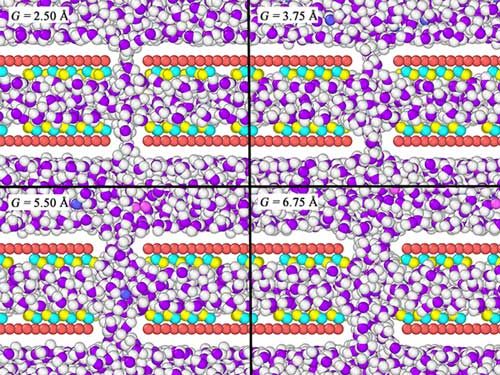Molecular Insights into Desalination with GO Membranes
Published on by Water Network Research, Official research team of The Water Network in Academic
Scientists performed a pressure-driven flow simulation of ionic aqueous solutions across bilayer graphene oxide (GO) membranes to investigate the effects of staggered nanoslits on desalination properties using classical molecular dynamics (MD) simulation.
By Michael Berger
They performed reverse osmosis (RO) pressure-driven flow to investigate the effect of geometrical parameters and salt species on the performance of GO membranes.

Representative snapshot with different distances of nanoslits. The red, lime, and yellow spheres, respectively, represent the carbon atoms, oxygen atoms, and hydrogen atoms, which make up the GO sheets. The purple, white, blue, and pink spheres correspondingly denote the oxygen atoms, hydrogen atoms, cations, and anions, which make up the ionic aqueous solution. (© ACS)
Presenting their findings in ACS Applied Materials & Interfaces ("Molecular Insight into Water Desalination across Multilayer Graphene Oxide Membranes"), a team from China monitored the water flux across the membrane with variation of geometry parameters (i.e., width of gaps and offsetting between two staggered gaps) and made a comparison with the infiltration predicted by the continuum model.
They report good agreement between the MD results and the developed theoretical continuum calculations with modified geometry parameters.
The synthesized flow model used by the team can be divided into three parts: the entrance of a nanoslit; the conjunction between the gap and passage; and the interlayer inside the capillary channel.The whole permeation of the GO films is dependent on the series-parallel combination of three resistances in these three parts.
The scientists monitored variable configurational parameters to elucidate the effect of different structures.To eliminate the variance between the classical model and nanoscaled flow, which is caused by the effect of size on the shrunken real flow area, they obtained modified geometrical parameters from density analysis.
MD results show that the water flow rate has a parabolic relation with slit width and decreases for a greater slit alignment, quantitatively in agreement with the theoretical prediction with modified geometrical parameters.
Read full article: Nano Werk
Media
Taxonomy
- Membranes
- Energy Efficiency
- Desalination
- Membrane Technology
- Membrane Filtration
- Sustainable Desalination
- Desalination
- Graphene